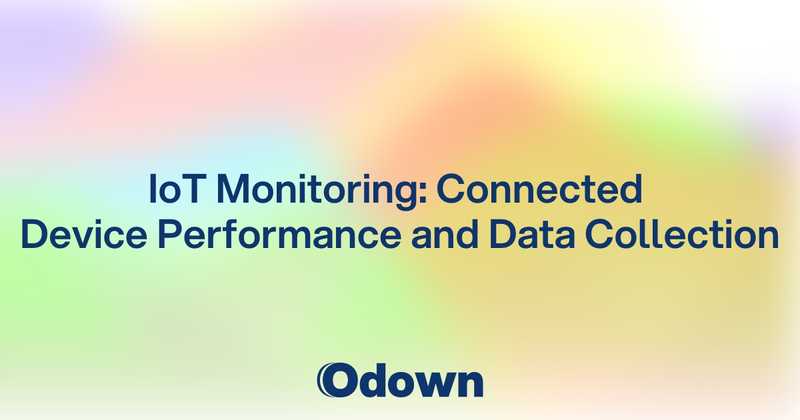IoT Monitoring: Connected Device Performance and Data Collection
Your smart factory is equipped with 5,000 sensors monitoring everything from temperature and humidity to machine vibrations and production quality. Your IoT dashboard shows green across the board - all devices are connected, data is flowing, and alerts are quiet. Then you discover that Production Line 7 has been producing defective parts for the past six hours because a critical temperature sensor has been sending stale data, but your monitoring system couldn't detect the difference between fresh readings and cached values.
This scenario illustrates the fundamental challenge of IoT monitoring. Traditional IT monitoring focuses on servers and applications that are designed to be observable and manageable. IoT devices often operate in harsh environments, have limited communication capabilities, run on battery power, and can fail in ways that aren't immediately obvious from basic connectivity checks.
IoT monitoring requires understanding the physical world constraints that affect connected devices. Network connectivity might be intermittent. Power sources might be unreliable. Environmental conditions might affect sensor accuracy. Device lifecycles might span years rather than the months typical for IT equipment, requiring monitoring strategies that account for gradual degradation and aging.
IoT Device Health Monitoring: Connectivity and Performance Metrics
IoT device monitoring must track both digital connectivity and physical device health indicators that affect data quality and device longevity.
Device Connectivity and Communication
IoT connectivity monitoring must account for the diverse communication technologies and network conditions that IoT devices experience.
Network connectivity monitoring tracks device online status across different communication protocols including WiFi, cellular, LoRaWAN, Zigbee, and proprietary wireless technologies.
Communication reliability monitoring tracks packet loss, message delivery success rates, and communication timeouts that might indicate network or device issues.
Signal strength monitoring tracks wireless signal quality for devices that depend on wireless connectivity, which often varies based on environmental conditions and interference.
Bandwidth utilization monitoring tracks how efficiently devices use available communication bandwidth, especially important for cellular IoT deployments with data usage costs.
Network handoff monitoring tracks how mobile IoT devices transition between different network coverage areas and identifies connectivity issues during movement.
Device Hardware Health
IoT device hardware operates in diverse environments that can affect performance and longevity in ways that traditional IT equipment doesn't experience.
Battery monitoring tracks power consumption, remaining battery life, and charging cycles for battery-powered IoT devices.
Temperature monitoring tracks device operating temperature and identifies overheating issues that might affect performance or device lifespan.
Memory utilization monitoring tracks available storage and memory on IoT devices that often have limited computational resources.
CPU performance monitoring tracks processing load on IoT devices and identifies when devices approach computational limits.
Storage health monitoring tracks flash memory wear and available storage space on devices that collect and buffer data locally.
Firmware and Software Health
IoT devices often run specialized firmware that requires different monitoring approaches than traditional server software.
Firmware version monitoring tracks software versions across device fleets and identifies devices that require updates for security or functionality improvements.
Boot and startup monitoring tracks device initialization processes and identifies devices that experience startup failures or extended boot times.
Application performance monitoring tracks specialized IoT applications running on devices and identifies software issues that might affect data collection or device functionality.
Memory leak detection monitors gradual memory consumption increases that might indicate software issues requiring device restart or firmware updates.
Error logging monitoring tracks device-level errors and exceptions that might indicate software or hardware issues requiring attention.
Device Lifecycle Management
IoT devices often have longer lifecycles than traditional IT equipment, requiring monitoring that supports long-term device management.
Device age monitoring tracks how long devices have been deployed and correlates device age with performance degradation or failure rates.
Maintenance schedule monitoring tracks preventive maintenance requirements and identifies devices that require physical inspection or service.
End-of-life monitoring identifies devices approaching end-of-support dates or those that should be replaced based on performance degradation.
Warranty tracking monitors device warranty status and correlates warranty coverage with maintenance and replacement decisions.
Sensor Data Collection and Quality Monitoring
IoT sensor monitoring must ensure data accuracy and quality while accounting for the physical phenomena that sensors measure.
Data Quality and Accuracy
Sensor data quality monitoring validates that collected data accurately represents real-world conditions and identifies sensors that might be malfunctioning.
Sensor calibration monitoring tracks when sensors were last calibrated and identifies sensors that might require recalibration to maintain accuracy.
Data range validation monitors whether sensor readings fall within expected ranges based on physical constraints and historical patterns.
Drift detection monitoring identifies gradual changes in sensor readings that might indicate sensor degradation or calibration drift.
Cross-sensor validation compares readings from multiple sensors measuring similar phenomena to identify outliers or malfunctioning sensors.
Environmental correlation monitoring validates that sensor readings correlate appropriately with environmental conditions and other sensor data.
Data Collection and Transmission
IoT data collection monitoring ensures that sensor data reaches central systems reliably and without corruption.
Data transmission monitoring tracks successful data upload rates and identifies devices that experience communication failures.
Message queue monitoring tracks data buffering on devices and identifies devices that might be accumulating unsent data due to connectivity issues.
Data compression monitoring tracks how efficiently devices compress sensor data to optimize bandwidth usage and transmission costs.
Timestamp accuracy monitoring ensures that sensor data includes accurate timing information that supports proper data analysis and correlation.
Data format validation monitors data structure and format consistency to identify parsing errors or data corruption issues.
Real-Time vs Batch Data Processing
IoT monitoring must support both real-time data streaming and batch data collection patterns depending on application requirements.
Real-time streaming monitoring tracks continuous data flows from sensors and identifies disruptions that might affect time-sensitive applications.
Batch upload monitoring tracks scheduled data transmission and identifies devices that fail to upload data according to expected schedules.
Data latency monitoring tracks delays between data collection and availability in central systems, which affects real-time decision-making capabilities.
Data synchronization monitoring ensures that data from different sensors maintains proper timing relationships for accurate analysis.
Sensor-Specific Monitoring
Different sensor types have unique characteristics that require specialized monitoring approaches.
Environmental sensor monitoring tracks temperature, humidity, pressure, and other environmental sensors that might be affected by extreme conditions.
Motion and vibration sensor monitoring tracks accelerometers and gyroscopes that might be sensitive to mechanical stress or installation issues.
Chemical sensor monitoring tracks gas sensors, pH sensors, and other chemical measurement devices that might be affected by contamination or exposure.
Optical sensor monitoring tracks cameras, light sensors, and other optical devices that might be affected by lighting conditions or lens contamination.
IoT Network Monitoring: Edge Computing and Connectivity
IoT networks often span from edge devices through gateways to cloud infrastructure, requiring comprehensive monitoring across all network layers.
Edge Gateway and Hub Monitoring
IoT gateways serve as critical communication bridges between edge devices and central systems, requiring specialized monitoring.
Gateway connectivity monitoring tracks communication between gateways and both edge devices and central cloud systems.
Data aggregation monitoring tracks how gateways collect, process, and forward data from multiple edge devices.
Protocol translation monitoring tracks how gateways convert between different communication protocols used by edge devices and cloud systems.
Local processing monitoring tracks edge computing capabilities that process data locally before forwarding to central systems.
Gateway redundancy monitoring tracks backup communication paths and failover capabilities when primary gateways experience issues.
Network Infrastructure Monitoring
IoT networks often use specialized infrastructure that requires different monitoring approaches than traditional enterprise networks.
Wireless network monitoring tracks WiFi, cellular, and other wireless infrastructure performance that supports IoT device connectivity.
LoRaWAN and LPWAN monitoring tracks low-power wide-area networks designed specifically for IoT device communication.
Mesh network monitoring tracks self-organizing networks where IoT devices communicate through other devices to reach central systems.
Network coverage monitoring tracks communication range and identifies dead zones where IoT devices might lose connectivity.
Interference monitoring tracks wireless interference that might affect IoT device communication reliability.
Edge Computing Performance
Edge computing brings data processing closer to IoT devices, requiring monitoring that tracks distributed computing performance.
Edge server monitoring tracks computational resources available for local data processing and analytics.
Edge-to-cloud communication monitoring tracks how edge computing systems communicate with central cloud infrastructure.
Local data storage monitoring tracks edge storage capabilities and data retention policies for offline operation.
Edge analytics monitoring tracks real-time data processing capabilities and identifies performance bottlenecks in edge computing workflows.
Load balancing monitoring tracks how processing load distributes across edge computing infrastructure.
Network Security and Isolation
IoT networks require security monitoring that accounts for the limited security capabilities of many IoT devices.
Network segmentation monitoring ensures that IoT devices remain isolated from critical enterprise networks and systems.
Traffic analysis monitoring tracks communication patterns and identifies unusual traffic that might indicate security issues.
VPN and tunnel monitoring tracks secure communication channels between IoT networks and central management systems.
Firewall monitoring tracks network security policies and identifies unauthorized communication attempts.
IoT Security Monitoring: Device Authentication and Data Protection
IoT security monitoring must address the unique vulnerabilities and attack vectors that affect connected devices and IoT networks.
Device Authentication and Identity
IoT device authentication monitoring ensures that only authorized devices can access networks and systems.
Device certificate monitoring tracks PKI certificates used for device authentication and identifies certificates approaching expiration.
Device identity verification monitoring tracks device enrollment processes and identifies unauthorized devices attempting to join networks.
Credential rotation monitoring tracks security credential updates and identifies devices that might have stale or compromised credentials.
Device registration monitoring tracks new device additions to networks and ensures proper security provisioning.
Behavioral authentication monitoring tracks device communication patterns to identify potentially compromised devices.
Data Protection and Encryption
IoT data protection monitoring ensures that sensitive data remains secure during collection, transmission, and storage.
Encryption monitoring tracks end-to-end encryption for IoT data transmission and identifies unencrypted communication channels.
Key management monitoring tracks encryption key distribution and rotation for IoT devices and communication systems.
Data anonymization monitoring tracks privacy protection measures for IoT data that might contain personally identifiable information.
Secure storage monitoring tracks how IoT data is protected in local device storage and central systems.
Vulnerability and Threat Detection
IoT security monitoring must detect threats that specifically target connected devices and IoT infrastructure.
Vulnerability scanning monitoring tracks known security vulnerabilities in IoT device firmware and software.
Malware detection monitoring identifies malicious software that might target IoT devices or use them for botnet activities.
Unauthorized access monitoring tracks login attempts and access patterns that might indicate compromise.
DDoS attack monitoring tracks distributed denial of service attacks that might target IoT infrastructure or use compromised IoT devices.
Physical tampering monitoring tracks signs of physical device tampering or unauthorized access to IoT hardware.
Compliance and Privacy Monitoring
IoT deployments often must comply with privacy regulations and industry standards that affect monitoring requirements.
GDPR compliance monitoring tracks personal data collection and processing by IoT systems to ensure privacy regulation compliance.
Data retention monitoring tracks how long IoT data is stored and ensures compliance with data retention policies and regulations.
Consent management monitoring tracks user consent for IoT data collection and processing.
Cross-border data transfer monitoring tracks international data flows from IoT systems and ensures compliance with data localization requirements.
Industry compliance monitoring tracks adherence to industry-specific regulations that might affect IoT deployments in healthcare, automotive, or other regulated industries.
IoT monitoring transforms connected device deployments from black box installations into transparent, manageable systems that deliver reliable data and services. Instead of hoping that sensors and devices work correctly, you get comprehensive visibility into device health, data quality, and network performance.
The investment in comprehensive IoT monitoring pays dividends in improved data quality, reduced maintenance costs, and proactive problem resolution that prevents device failures from affecting business operations. You finally get the visibility needed to manage large-scale IoT deployments with confidence.
Ready to implement comprehensive IoT monitoring? Odown provides scalable monitoring that tracks device health, connectivity, and data quality across diverse IoT deployments. Combined with our gaming platform monitoring expertise, you'll have monitoring strategies that work for both real-time, latency-sensitive applications and distributed device management across large geographic areas.



